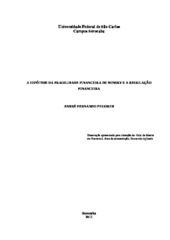| dc.contributor.author | Pegorer, André Fernando | |
| dc.date.accessioned | 2016-06-02T19:33:08Z | |
| dc.date.available | 2012-12-07 | |
| dc.date.available | 2016-06-02T19:33:08Z | |
| dc.date.issued | 2012-12-16 | |
| dc.identifier.citation | PEGORER, André Fernando. A hipótese da fragilidade financeira de Minsky e a regulação financeira. 2012. 112 f. Dissertação (Mestrado em Economia) - Universidade Federal de São Carlos, Sorocaba, 2012. | por |
| dc.identifier.uri | https://repositorio.ufscar.br/handle/ufscar/2148 | |
| dc.description.abstract | Given the complexity of financial instruments currently in use, the purpose of this study is to examine, according to the proposed economic theory of Hyman P. Minsky, the factors that led to the recent financial crisis, which began in the mortgage market and expanded throughout the financial system. The residential mortgage market, as well as the financial regulation and supervision frameworks, was examined based on the Financial Fragility Hypothesis and the theory of financial cycles, as proposed by Minsky. The framework that the financial structure created prior to the crisis would not have been possible without the use of credit derivatives. This research finds that the use of credit derivatives were the primary financial instrument that drove the expansion of the credit cycle and produced vast losses during the crisis. This new financial structure, burdened by a complex structured finance, amplified the positive outlook of economic units and that allow very high credit expansion rates for a long period. And its collapse required the ensuing government intervention in the economy. Such intervention, which occurred through fiscal and monetary policies and a direct rescue of failing institutions, was necessary in both preventing the full collapse of the entire financial system and in stabilizing it. This study additionally applies an econometric model of the Minskyan theory to test whether the use of credit derivatives contributed to expanding the fragility of the financial system during its expansion. Finally, the study analyzes the drivers of the strong growth rate of the credit derivatives markets in the context of financial regulation, as such markets are exposed to high risk and therefore have a significant potential to increase financial fragility. | eng |
| dc.description.sponsorship | Financiadora de Estudos e Projetos | |
| dc.format | application/pdf | por |
| dc.language | por | por |
| dc.publisher | Universidade Federal de São Carlos | por |
| dc.rights | Acesso Aberto | por |
| dc.subject | ciclos econômicos | por |
| dc.subject | Minsky, Hyman P., 1919 | por |
| dc.subject | crise financeira | por |
| dc.subject | instabilidade financeira | por |
| dc.subject | teoria Minskyana | por |
| dc.subject | financial instability | eng |
| dc.subject | Minskyan theory | eng |
| dc.subject | financial crisis | eng |
| dc.title | A hipótese da fragilidade financeira de Minsky e a regulação financeira | por |
| dc.type | Dissertação | por |
| dc.contributor.advisor1 | Cruz Júnior, José César | |
| dc.contributor.advisor1Lattes | http://lattes.cnpq.br/0086426315229286 | por |
| dc.contributor.referee1 | Diegues Júnior, Antonio Carlos | |
| dc.contributor.referee1Lattes | http://lattes.cnpq.br/0594188577645269 | por |
| dc.description.resumo | Diante da complexidade dos instrumentos financeiros existentes, este trabalho busca esclarecer, segundo a teoria econômica proposta por Hyman P. Minsky, quais foram os fatores que levaram a crise financeira recente, que teve seu inicio no mercado imobiliário, a se expandir de forma intensa por todo o sistema financeiro internacional. Baseando-se na Hipotese da Fragilidade Financeira e na teoria econômica de ciclos financeiros, propostas por Minsky, foi analisada a estrutura de financiamento imobiliário nos Estados Unidos. As estruturas de regulação e supervisão financeira também foram analisadas aos olhos da teoria Minskyana. Alem disso, foi testada a hipótese de que a estrutura financeira criada neste período não seria possível sem a utilização peculiar dos derivativos de credito. Estes foram identificados como sendo o principal instrumento financeiro tanto no estimulo do ciclo de ascensão do credito quanto no colapso da nova estrutura financeira, que, permeada por produtos estruturados complexos, exacerbou as expectativas positivas dos agentes ao permitir que elevadas taxas de crescimento do credito fossem mantidas por um longo período de tempo. Com o colapso desta estrutura, fez-se necessária a intervenção do governo na economia. As intervenções, que ocorreram através de políticas fiscais, monetárias e de socorro as instituições em estado precário, foram necessárias para evitar o colapso do sistema financeiro e restabelecer a estabilidade do mesmo. Diante destes ocorridos e tento em vista a interação existente entre os diferentes agentes financeiros, foi criado um modelo testável empiricamente para a teoria Minskyana. Este modelo buscou responder se o amplo uso de derivativos de credito foi capaz de aumentar a fragilidade financeira de todo o sistema durante o período de expansão econômica. Por fim, a estrutura regulatória dos derivativos financeiros foi analisada de forma a ilustrar os motivos que levaram ao amplo crescimento do mercado de derivativos de credito, um mercado marcado por elevada exposição a riscos e, portanto, propenso a contribuir com a elevação da fragilidade financeira. | por |
| dc.publisher.country | BR | por |
| dc.publisher.initials | UFSCar | por |
| dc.publisher.program | Programa de Pós-Graduação em Economia - PPGEc-So | por |
| dc.subject.cnpq | CIENCIAS SOCIAIS APLICADAS::ECONOMIA::ECONOMIA MONETARIA E FISCAL | por |
| dc.contributor.authorlattes | http://lattes.cnpq.br/9421539373648875 | por |
